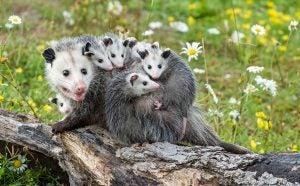The opossum, one of about 100 species in the order Didelphimorphia, has graced the frying pan of many an old hillbilly, as well as the pavement in front of their farms. But whether they are allies, villains, or just tasty stew meat remains a bit of a puzzle. Pros and cons abound with regards to seeing around your farm the only marsupial found naturally north of Mexico.
What are they?
Although the lexicon of American farm folk might suggest otherwise, the “possum” and the “opossum” are actually distinct one from the other, with the former being an Australian marsupial more closely related to the kangaroo than its North American cousin. Considered a medium-sized mammal, the Virginia opossum is typically 14 to 37 inches in length and can weigh anywhere from 1.8 to 14 pounds, while the Brushtail opossum comes in somewhat smaller. With more than 50 teeth, it has more chompers than any other North American land mammal, as well as a tail that serves as a fifth appendage, capable of grasping like a hand.

The mother opossum may give birth to as many as 20 “joeys” about the size of honeybees, but fewer than half will survive. You’ve most likely seen a mother carrying a litter around on her back, after they’ve crawled out of her pouch at 2 months old. Babies will stay with their mothers about 100 days before venturing off on their own. But they don’t always stay single for long. Both male and females will cohabitate in dens as part of a group even if not mating and clean themselves much like cats so as to brush off smells which might attract predators.
FICTION: The opossum carries a number of parasites and diseases.
FACT: While the opossum isn’t perfectly immune to rabies, marsupials in general have a lower body temperature than placental animals, meaning their bodies aren’t hospitable to the virus. Also, the omnivorous opossum sees the disease-spreading ticks of this world as a veritable buffet. The National Wildlife Federation estimates that a single opossum eats at least 5,000 per season, which means your dog really should be nicer to them. The black-legged ticks such as deer ticks, which spread Lyme’s disease, happen to be a particular delicacy. An experiment conducted at the Cary Institute placed the opossum up against chipmunks, squirrels, mice, and catbirds in a tick-eating contest, with 100 offered to each, and the opossum came away the undisputed champ. Disease-spreading cockroaches, crickets and beetles are also high on their list of favorites, bringing to mind the old phrase, “Your enemy’s enemy is your ally.”
FICTION: The opossum is harmless to farmers.
FACT: We wouldn’t go that far. The opossum does like a good chicken dinner. And your corn, beans, and other livestock feed as well. Also, horse-owners, in particular, should be concerned about equine protozoal myeloencephalitis (EPM), a neurologic disease which can cause big problems. Caused by Sarcocystis neurona, a parasite that attacks the brain and spinal cord, the disease can be lethal and is primarily carried by opossums. Horses can be become infected by grazing or ingesting feed contaminated by the opossum, and while EPM is not passed horse-to-horse, chances are if one is grazing in an affected area, the others are as well.
View this post on Instagram
FICTION: The opossum attracts mice and other vermin.
FACT: Actually, if you see mice near the opossum’s path, it might be due to the lack of snakes. A particular peptide in the opossum makes it immune to the venom of nearly every snake, save the coral snake. This makes the snake a fine length of dinner for the hungry opossum once they’ve warmed up on ticks … and perhaps the chickens that the snake was originally seeking. Some research indicates that the peptide found in the opossum can be re-created; experimenters have done this to mice and made them immune to rattlesnake venom.
FICTION: The opossum “plays dead” at will.
FACT: The move for which it’s best known turns out to be completely involuntary. When experiencing great fear or stress, the opossum completely freezes up in a state much like a human coma. With its tongue stuck out and eyes completely open, the opossum might remain in this state for several hours, completely beyond its control.
FICTION: The opossum is a dim-witted creature.
FACT: Researchers have demonstrated that the opossum has a superior memory for which route which leads to food. When tested against dogs, cats, rats, and pigs, the opossum came out on top. It also remembers the smell of a toxic substance for up to a year after trying it.
FICTION: The opossum would make an awesome pet.
FACT: Well, that might be a stretch. The fact is, an opossum does stink. Armed much like a skunk with a putrid odor coming straight from glands inside its anus, the opossum emits this while “playing dead” due to fear. Every. Single. Time. This is its body’s way of warding off potential predators, or human owners, or other pets for that matter.
All in all, whether the opossum is a friend or foe largely hinges on what kind of operation you’re running. But to say they’re all bad would be missing the opportunity for a pot full of opossum gumbo.
Brian Boyce is an award-winning writer living on a farm in west-central Indiana. You can see more of his work at www.boycegroupinc.com.



